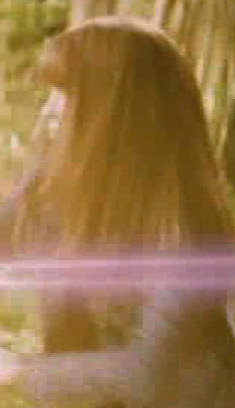Here's what fake HD video looks like

After this morning's piece "Don’t believe the low bit-rate ‘HD’ lie", I thought I would follow up and show you want crappy HD looks like. The following is a sample from AVSForum user Xylon who digitally ripped some images from DIRECTV and Dish Networks satellite service 1.5 years ago. Note that both of these are delivering less than half the 19.2 bit-rate of ATSC over-the-air broadcast HD so neither example is all that great. I linked to the forum and cropped out the image at 1:1 size and posted the samples for a side-by-side comparison below but you can click to see the full-size images.
| DIRECTV HD @ 8.25 mbps | Dish "HD" @ 9.10 mbps |
 |
Apparently, DIRECTV switched from 1920x1080 resolution HD video to highly compressed 1280x1080 so they can shove a lot more channels on to their service which users not-so-lovingly named "HD Lite". As you can see above, the DIRECTV image to the left absolutely stinks compared to the not-so-great sample from Dish on the right. This apparently angered a lot of DIRECTV customers and one such customer Peter Cohen actually filed a class action lawsuit.
Even the Dish example on the right above sucks compared to broadcast HDTV and that the hair is blurred and blended in. But everyone's rushing to announce their "100 channel HD" service when all they're doing is squeezing twice as many channels down the same pipe. Now imagine what happens when you try to cut the bit-rate down by a factor of 4 like Apple's iTune HD rental service or you try to cut it down 10 times like some websites. Granted the usage of higher-end codecs like H.264/MPEG4-AVC or VC-1 can lessen the losses in quality, but no compression technology in the world can handle fast changing video with low bit-rates without severe degradation. People often hear MPEG-4 and the knee-jerk reaction is that it's automatically better than MPEG-2 because they see a bigger number but that's only true if it's at or almost the same bit-rate.
In light of the fact that 8 mbps 1280x1080 video gets you sued, you have to wonder what Steve Jobs is thinking when he says Blu-ray and HD DVD will get killed by download services such as his newly launched 4 mbps 720p "HD" iTunes movie rental service. I guess if consumers believe the lie that you can do HD with these low bit-rate downloads, then Steve might be right. But with cheap 42 inch 1920x1080 full 1080p LCD and Plasma panels coming out spring this year at less than $1400, consumers are going to be in for a surprise when they see the difference between the free stuff coming over the airwaves versus the crap they actually pay for coming from Satellite and download services.
Video quality reference table from best to worst: (Some data might be outdated, missing, or approximate but I will update)
| Source/service | CODEC | Resolution | Bit-rate |
| Blu-ray | H.264 or MPEG2 | 1920x1080 1080i/p | 40 |
| HD DVD | H.264 or VC-1 | 1920x1080 1080i/p | 28 |
| ATSC HDTV | MPEG2 | 1920x1080 1080i/p | 19.39 |
| Digital cable | MPEG2 | 1920x1080 1080i/p | ~ 16 |
| Verizon FiOS Video on demand | MPEG2 | 1920x1080 1080i | 15 |
| DISH HD | MPEG2/MPEG4 | 1440x1080 | < 10 |
| DIRECTV HD | MPEG2/MPEG4 | 1280x1080 | < 10 |
| IPTV | H.264 | ? | < 10 |
| Xbox Live Video | VC-1 | 1280x720 720p | 6.8 |
| DVD | MPEG2 | 720x480 480i * | 8 |
| Apple iTunes | QuickTime/H.264 | 1280x720 720p | 4 |
| Web "HD" downloads | H.264 | 1280x720 720p | 1.5 |